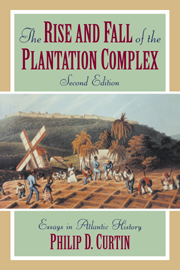Book contents
- Frontmatter
- Contents
- Preface
- Preface to first edition
- Beginnings
- Seventeenth-century transition
- Apogee and revolution
- 9 The slave trade and the West African economy in the eighteenth century
- 10 Atlantic commerce in the eighteenth century
- 11 The Democratic Revolution in the Atlantic basin
- 12 Revolution in the French Antilles
- Aftermath
- Appendix
- Index
10 - Atlantic commerce in the eighteenth century
Published online by Cambridge University Press: 05 June 2012
- Frontmatter
- Contents
- Preface
- Preface to first edition
- Beginnings
- Seventeenth-century transition
- Apogee and revolution
- 9 The slave trade and the West African economy in the eighteenth century
- 10 Atlantic commerce in the eighteenth century
- 11 The Democratic Revolution in the Atlantic basin
- 12 Revolution in the French Antilles
- Aftermath
- Appendix
- Index
Summary
The tropical plantation had become, by the eighteenth century, a peculiarly specialized economic institution. It produced one or two products, which were sold at a great distance. The factors of production were not merely local land and capital, but capital and managerial labor from Europe, other workers from Africa, and associated products as diverse as Indian cloth to buy slaves, European cloth for them to wear, and New England barrel staves to make hogsheads for shipping sugar. The plantation complex, in short, was carried by oceanic trade over long routes stretching from the Pacific coast of Peru in the west to the Bay of Bengal in the east.
Bureaucrats and private traders
European intentions in the outer world had been clear from the earliest expeditions to India and the Antilles. Crown bureaucracies intended to make the overseas ventures profitable for the crown, producing either revenue for the monarch or power for the state – preferably both. Private traders had a lot in common with the free lances of the Spanish conquest. They were among the most self-interested and independent of the early capitalist firms. Though not always as violent and independent as the seventeenth-century buccaneers, they were equally anxious to evade control over their operations, and conditions were such that they were often successful.
- Type
- Chapter
- Information
- The Rise and Fall of the Plantation ComplexEssays in Atlantic History, pp. 129 - 143Publisher: Cambridge University PressPrint publication year: 1998

